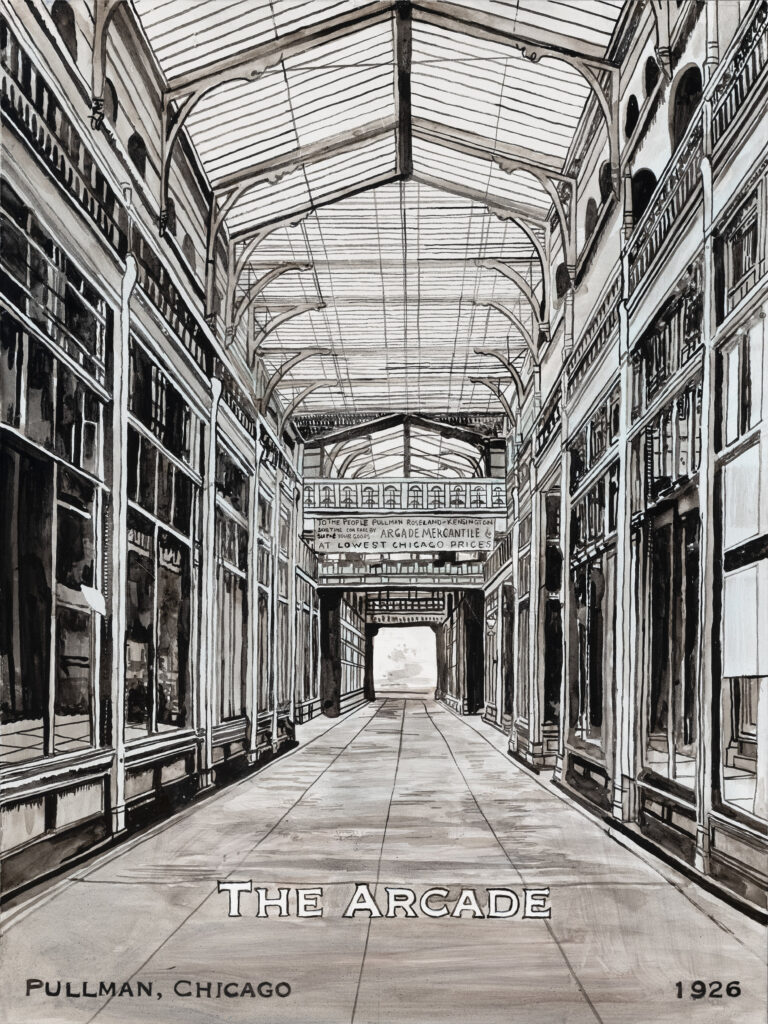Chicago, Illinois, USA
Demolished 1926

Pullman is a legendary Chicago neighborhood of particular interest to anyone keen on labor history, urban planning, or trains. It is one of the few remaining historic company towns (built in 1881) in the US that is relatively intact. I was first drawn to Pullman in the late 1980s as a photography student. The Pullman Palace Car Company hired architect Solon Spencer Beman to design the factory for its sleeper rail car production as well as housing for the workers. All the structures used brick made of clay dredged from nearby Lake Calumet. One of the grand public spaces that Beman designed was the Arcade with shops and post office on the ground floor and library, theater, and meeting rooms on the upper floors. In 1926, it was demolished. I moved to Chicago decades after that first visit and eventually ended up in Pullman. When I walk through Arcade Park on the way to and from the train, I often wonder what it might have been like to be able to take a shortcut through the wide sheltered passageways. Ruth L.
The Arcade Building was a proto shopping center, built as part of Pullman’s model town, constructed in 1881-82. It was a three story building, with skylights, with multiple shops, an auditorium, a post office and a real community center, torn down in 1926. This building is central to the Pullman story and Pullman’s concept of a “model town.” Mike M.
The town of Pullman (incorporated into Chicago in 1889) was founded in 1881 by George Pullman as a model town for employees of his railway car company, the Pullman Palace Car Company. The town, which was designed by architect Solon Spencer Beman, provided workers with rental housing with such novel amenities as indoor plumbing, gas, and sewers as well as other facilities. The arcade, which opened in 1882 was intended as one of the social and economic cornerstones of the town. It was the largest non-factory building in Pullman, covering about an acre. The ground floor contained shops which advertised competitive Chicago prices, a bank and a post office; the second floor included a library and a 1,000 seat theater and other general-use rooms. The third floor was dedicated to meeting rooms for various associations, including the Masons and Odd Fellows. In the depression following the Panic of 1893, demand for railway cars slackened and the company laid off many workers and switched others to piece-work. The resulting loss in income rendered the unchanged rents and gas and water rates beyond the means of most workers and, combined with irritation with the rigid paternalistic control (and lack of democratic structures) of the town and the refusal by the company to allow workers to buy and own houses, led first to the seminal Pullman Strike in 1894. After the failure of a strike by the American Railway Union (ARU) led by Eugene Debs against the the Pullman factory, the ARU launched a hugely disruptive national boycott of all trains carrying Pullman passenger cars. When the ARU defied a federal court order to stop the boycott, President Grover Cleveland sent in the U.S. Army to get the trains moving. The resulting violence and riots (30 people died in Chicago alone) led to the dissolution of ARU and the imprisonment of its leaders.After George Pullman’s death in 1897, the Illinois Supreme Court required the company to sell the town and In 1889, the town was annexed by the city of Chicago, which eventually sold the houses to their occupants. The arcade fell into disrepair and was demolished in 1926.
The painting is based on an old uncredited black-and-white photograph.
No. 233